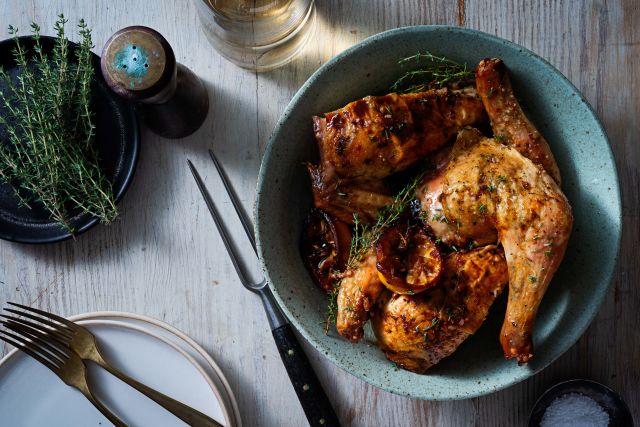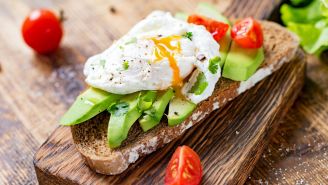This recipe from The What To Eat When Cookbook takes a little prep work, in the form of a dry brine, but the flavor is worth the effort. Chicken provides great protein power without the amino acids in red meat that cause the bacteria in your gut to turn pro-inflammatory. And lean meats at lunch are a great choice for fighting fatigue. Of course, chicken is the main event here, so try to get the best chicken you can that is within your budget.
Prep: 25 minutes, plus overnight marinating
Cook: 50–55 minutes
Makes: 4 servings
Serving Size: 1/4 chicken
Ingredients
1 large lemon
1 tablespoon fresh thyme, finely chopped
1 teaspoon fine sea salt
3/4 teaspoon freshly ground pepper
1 whole chicken (4 pounds)
Extra-virgin olive oil
1/2 cup dry white wine
Directions
1. Finely zest the peel of the lemon into a small bowl (about 1 1/2 teaspoons). Wrap the lemon; refrigerate and reserve for roasting the chicken. Add the thyme, salt, and pepper to the lemon zest, and mix the dry brine to blend.
2. Place the chicken, breast side down, on a work surface. Using kitchen shears, cut out the backbone of the chicken and discard. Break the joints so that the legs lay flat. Pat the chicken dry with paper towels. Turn the chicken breast side up on the work surface. Using your fingers, carefully loosen the skin over the breast, thighs, and legs. Using your fingers, evenly spread and distribute three-quarters of the dry brine mixture under the skin over the breast, thighs, and legs, being careful not to tear the skin. Rub the remaining dry brine all over the outside of the chicken. Place the chicken on a platter. Tuck the wingtips underneath the breast, so that the breast skin is completely exposed. Refrigerate, uncovered, for at least 4 hours or overnight.
3. Preheat the oven to 425°F. Place a large cast-iron skillet in the oven to heat for 15 minutes.
4. Pour 1 tablespoon olive oil over the chicken and rub all over the skin to coat. Remove the skillet from the oven and place the chicken in it. Cut the reserved lemon in half and add to the skillet. Return the skillet to the oven and roast the chicken for 30 minutes. Add the wine to the skillet. Continue to roast the chicken until the skin is brown and crisp and an instant-read thermometer inserted into the thickest part of the thigh registers 160°F to 165°F, 15 to 20 minutes longer. Remove the skillet from the oven and transfer the chicken to a plate; let rest for 10 minutes.
5. Meanwhile, using tongs, rub the lemon halves, flesh side down, in the bottom of the skillet, to remove any browned bits and to combine the lemon juice with the accumulated sauce in the skillet.
6. Cut the chicken into pieces. Serve with the sauce.
Calories: 554.16 kcal; Total fiber: 0.8 g; Soluble fiber: 0 g; Protein: 42.9 g; Total fat: 38.2 g; Saturated fat: 10.4 g; Healthy fats: 24.8 g; Carbohydrates: 2.2 g; Sugars: 0.3 g; Added sugars: 0 g; Sodium: 933 mg; Potassium: 443 mg; Magnesium: 48 mg; Calcium: 52 mg
Excerpted from The What to Eat When Cookbook, by Michael F. Roizen, MD, Michael Crupain, MD, MPH, and Jim Perko, Sr., CDC, AAC. Copyright © 2020 by Michael F. Roizen, MD. Reprinted by permission from National Geographic. Photo credit: Scott Suchman.





